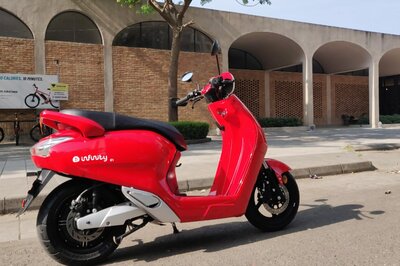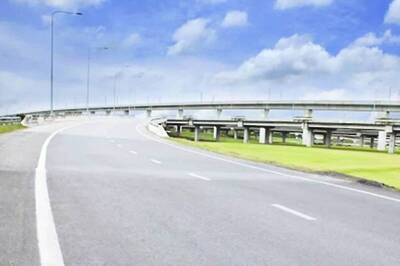
views
Diwali 2019 was no different compared to past years for Delhi as the Air Quality Index (AQI) dipped to ‘severe’ levels the day after the festivities. The spike in pollution wasn’t surprising, and residents are now familiar with the situation. As the air grew more toxic, the Delhi government shut down schools and the Supreme Court-appointed Environment Pollution (Prevention & Control) Authority declared an emergency situation in the capital while directing the closure of all construction activities. And, the Aam Aadmi Party (AAP) government also ordered the odd-even car-rationing drive to combat the pollution.
The success of the scheme, which restricts private cars from driving on alternate days based on the last digit on their number plates, has proved that even the most severe environmental problem can be fought with political will and people’s participation. The system was piloted by Delhi in January 2016, becoming the first state to bring such a stringent anti-pollution emergency measure in India. The success of the scheme also brought for it the approval of the EPCA and it is now part of the Graded Response Action Plan (GRAP), an emergency mechanism to combat pollution. GRAP suggests that if the AQI reaches the emergency (severe-plus) level, then the odd-even drive should be implemented.
Following Supreme Court guidelines, the Delhi government planned the application of the scheme from November 4-15.
The odd-even plan has also faced significant criticism. While the AAP-led Delhi government and some researchers say that it is a proven emergency measure that will bring down pollution levels, opposition parties and other environmental groups maintain that this is just a political gimmick which has little or no impact on air quality.
But despite the flak, it’s clear that among all the north Indian states which are the worst-affected due to toxic air and smog, Delhi’s odd-even is the only and most stringent rule of its kind to curb pollution.
The research and the results
To evaluate the odd-even scheme correctly, we should compare observed air quality with what the levels could have been in the absence of the programme. Two rigorous studies have found that the plan had an impact as an emergency measure.
A paper authored by professors from IIT Delhi (Sourangsu Chowdhury, Sagnik Dey and others) utilised satellite-based estimates of PM2.5 (tiny particles that can be carried deep into the lungs) to examine their potential decrease due to reduced traffic emissions during the odd-even drive. The satellite-based estimates were calibrated against ground-based measurements, combined with chemical transport model simulations. The estimated PM2.5 represents the level between 10.30am and 1.30pm, when the satellites cross this region. The study concluded that the traffic restrictions between January 1 and 15 in 2016 reduced PM2.5 by four to six per cent with a maximum of up to 10 per cent, primarily at three local hotspots in Delhi. Analysis of meteorological parameters suggested a stagnation of pollutants just before and during the programme, thereby spoiling the effort.
Another paper, by researchers from Harvard University and the University of Chicago (Michael Greenstone, Rohini Pande, Santosh Harish, Anant Sudarshan) uses government monitoring data, and a statistical technique called difference-in-differences. The analysis compares Delhi’s monitors to monitors from neighbouring cities in the national capital region (NCR) using PM2.5 data before, during, and after the two pilot rounds in January and April 2016. The assessment technique assumes that air quality changes in similar ways within and outside Delhi due to meteorology and other factors that are common to both. This second analysis finds that PM2.5 levels were lower by 14-16 per cent on average between 8am and 8pm during the odd-even scheme in January 2016. No impact was detected at night. No impact was detected when the programme was repeated in April.
The scheme had met with some opposition and the Central Pollution Control Board had told the National Green Tribunal in 2016 that there was no data to suggest that the odd-even drive had any impact on the decrease in vehicular pollution and the fluctuations in PM10 and PM2.5 were due to weather and change in wind patterns.
According to a News18.com analysis of air quality data for the second and third-round of the scheme (April 2016 and November 2017) accessed from Berkeley Earth, a California based non-profit, air quality in Delhi, in fact, deteriorated during the odd-even programme.
For instance, the average concentration of PM2.5 in Delhi during the second run of the drive between April 1 and April 15, 2016 was 116 µg/m³ whereas it was 82 µg/m³ and 92 µg/m³ during the same period in 2017 and 2018, respectively when there was no special pollution control plan in place, the data suggested.
Similarly, during the third round from November 13 to November 17, 2017, average PM2.5 stood at 218 µg/m³. In contrast, it was 171 µg/m³ in 2016 and 140 µg/m³ in 2018 without any traffic restrictions.
The result of studies have varied, but in the end the odd-even plan is an emergency measure and the main goal of it is not to bring down pollution significantly but to ensure that more pollutants are not added to the already polluted air.
Putting the brakes on pollution
While it is much desired that there are many long-term plans to combat air pollution, and the Delhi government is working on such measures, but steps like odd-even are an emergency recourse, and it is not the only or best solution to pollution.
Studies have shown that Delhi’s odd-even scheme had a significant impact on reducing traffic congestion, which in turn also impacts pollution. The total number of cars off the road is around 20-25 lakh a day during the drive. Most importantly, the Supreme Court-appointed EPCA has also recommended the odd-even drive as an emergency measure under GRAP if pollution levels jump to the ‘severe plus’ category and persist for 48 hours. The EPCA had last month asked Delhi and its neighbouring states to start enforcing GRAP from October 15.
The situation in 2019
Firstly, it should be accepted that air pollution is not a Delhi-centric problem, but a problem for the whole of north India. The pollution which causes the thick smog and turns the capital into a “gas chamber” has various sources like meteorological conditions, local pollution, altitude and crop-waste (stubble) burning in the adjoining states of Haryana and Punjab.
Significantly, this year the CPCB and government-run monitoring agency SAFAR also accepted that the spike in Delhi’s air toxicity took place due to stubble burning and that it contributes about 46 per cent to the pollution. Yes, it is true that it is not the only problem, but when stubble burning and low wind speeds along with decreasing temperatures come together, then this amalgamation results in a deadly condition.
The pollution problem is not a political one but the solution must be because it is not a challenge confined to Delhi. With about five different states involved, the Centre must intervene in this matter on an emergency basis. Punjab chief minister Captain Amarinder Singh himself recently said that without the participation of the central government, stubble burning cannot be stopped.
For the sake of our children, it is time to go above politics and work to find an answer to the pollution. The Delhi government has taken several steps, but it is not a matter of just one government. This is an issue which needs a collective political solution.
(The author is an Associate Fellow at the Delhi Assembly Research Centre. Views are personal)



















Comments
0 comment